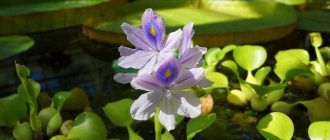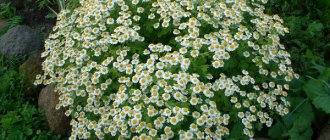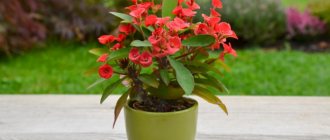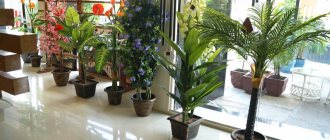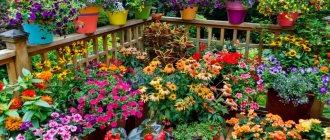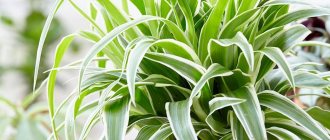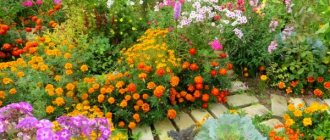Haworthia Cooper (Trunkata)
This amazing succulent evokes associations with science fiction films: the tips of its leaves are transparent, so the plant resembles a bunch of bubbles.
- Haworthia is undemanding in care.
- She loves the light that she absorbs through transparent “windows”, but is afraid of direct sunlight.
- The succulent can be placed on a windowsill, nightstand, or hung on a wall holder.
- In hot weather, you should water your haworthia once a week, and in winter - once a month.
What is the rarest flower?
The Red Middlemist is considered the rarest flower. Nature owes its preservation to man. John Middlemist, traveling in China, saw a magnificent flowering plant and brought it home. He did not even suspect that he had saved the culture from complete extinction.
To date, only two specimens of this plant have survived. One is in a greenhouse in New Zealand and the other in the UK. Of course, there may be a few more red camellias in private collections, but there is no reliable information on this matter.
Dischidia Raffles
A plant of the root-climbing family, which has a strange appearance and resembles a vine. Its peculiarity is that the leaves have an unusual shape: on the first level they are fleshy, and on the second they are large and bag-like. Under natural conditions, leaves accumulate rainwater. The length of dischidia can reach 5 meters.
Requires plenty of diffused light, temperatures from 18 to 30 degrees and high humidity. That is why flower growers prefer to grow dischidia in a florarium.
The most exotic flowers for the home
Fans of exotics will love these representatives of the flora, which can be grown indoors:
- Finger citron. The unusual citrus fruit resembles squid tentacles. Developed by Asian breeders, it is considered sacred by Hindus because its fruits resemble the Hand of Buddha. In nature it reaches 3.5 m, but the picture of an impressive tree should not be scary. In an apartment it does not grow more than one and a half meters. It blooms in spring and bears fruit in winter.
- Monstera. A bizarre vine, seen in the wild, instantly attracted attention due to its resemblance to a monster, giving rise to many legends and creepy rumors. When it was brought to Europe and America, the slander instantly disappeared. Liana became very popular. It grows to enormous sizes even at home. The large white flowers resemble ears of corn, and the leaves seem to be crocheted.
Monstera
- Cubanola. The Dominican Republic is the birthplace of the exotic. The inflorescences are bells that grow up to 20 cm. In room conditions it grows up to two meters and exudes an incredible aroma of chocolate. This handsome man looks luxurious and becomes a decoration of the entire interior.
- Pitahaya. The stems of the plant are spiny and long, hanging down. Snow-white buds bloom at night. The culture bears fruit. The fruit tastes like a mixture of banana, nut, kiwi and is incredibly healthy. Legend has it that the flower was “belched” onto the ground by a huge fire-breathing dragon.
- Sundew. Every fan of exotics will appreciate the flycatcher. Sweet droplets on the red fibers covering the leaves on long stems attract insects. Once they sit on the “nectar”, they can no longer get out.
- Pseudolitos. It is devoid of leaves, and the stem looks like a ball. Outwardly, it resembles a stone covered with brown-pink tubercles. The inflorescences with burgundy and brown petals give it special beauty.
Almost all exotics require the creation of special conditions of detention. Otherwise, they will simply disappear or refuse to bloom or bear fruit.
Homemade Cubanola
Crassula Wine Cup (Umbella)
This succulent is a relative of the common Crassula. Due to its unusual shape, Crassula is called the Wine Cup or Bowl.
- It is unpretentious, easily tolerates both bright light and shade, and can grow in dry soil for a long time, so it is excellent for growing by novice gardeners.
- Loves fresh air - you can take it out to the balcony.
Wine Cup juice is used for medicinal purposes, but should not be taken orally due to its high concentration of arsenic!
What are the most beautiful flowers?
There are many amazing plants, but these are the ones that cause the most admiration for their unique and original appearance:
- Black Takka. An incredibly beautiful flower, which is called the black lily or bat lily because of the shape of the petals. Many people note that the pronounced whiskers resemble those of a cat. Dark inflorescences are not just black, but have purple, cherry, grayish shades, and in appearance resemble orchids.
- Blue Tillandsia. Nature has literally endowed this flower with such beauty that to many it seems man-made. From a rosette with linear long leaves grows upward a soft purple flower, surrounded by red bracts, exuding a jasmine scent. All fans of the most beautiful and rare exotic flowers are trying to get this South American miracle into their collection.
- Poinsettia. Quite a rare flowering plant in our country. Its distinctive feature is the huge red inflorescences resembling stars. According to popular belief, it has therapeutic properties, ionizes and purifies the air, but is valued precisely for its incredible beauty.
Every culture is quite capricious. When deciding to add one of the listed specimens to your collection, you should take care in advance to create the most favorable conditions for keeping it.
Growing milkweed at home
Read the article about Indoor spurge: types, care features.
Mimosa bashful
You can occasionally surprise guests with this plant by lightly touching it: the mimosa curls up its leaves from any external irritants. In South Africa it is an evergreen shrub.
Do not keep in a house where animals live: mimosa leaves cause poisoning!
- In the spring-autumn period it grows well at a temperature of 20–24 degrees, and in winter – at 16–18.
- Tolerates even direct sunlight.
- In hot weather, it requires abundant and regular watering in the summer, and in the cold season, slightly moist soil is sufficient.
- It blooms with graceful spherical flowers of a soft lilac color.
- Due to tobacco smoke, it drops its leaves.
Why are rare indoor plants so popular today?
Plantomania, or obsessive love for plants, is a new trend of our time. Just like there was the tulip mania of the 17th century or the orchid mania of the Victorian era. The love for indoor plants that can be grown in pots began around 2000.
Thanks to the development of information technology, new fan pages, discussion forums and social groups are being created, whose members share their comments, achievements and successes in growing plants in pots. There are also communities that breed so-called pearl or rare houseplants. Their owners share not only their own observations or experiences, but also the seedlings they have grown or finished specimens.
Arabian adenium (Adenium obesum)
A rare exotic xerophytic houseplant native to the arid desert regions of Africa, also known as the desert rose. Due to its characteristic thick, bottle-shaped stem base, it resembles a bonsai tree. In fact, this swollen trunk serves to store water during times of shortage. It blooms in spring in the form of delicate stars - single or full flowers in shades of white, pink, purple or magenta depending on the variety.
Arabian adenium (Adenium obesum)
Arabian adenium requires plenty of light, high temperatures (ideally above 30°C) and regular watering. To avoid root rot, the plant must be provided with very good drainage; expanded clay is commonly used for these purposes.
In winter, this plant goes into a dormant period, so all its leaves may fall off. During this period, desert rose requires a special room with a temperature of about 12°C, plenty of light and limited watering. If the weather outside is favorable, that is, above 21°C, it can be placed on a balcony or terrace to stimulate growth.
In order for Arabian adenium to bloom, it needs fertilizers, preferably for flowering cacti. Propagation is carried out by shoot cuttings or sowing seeds. The most common diseases are bacterial and fungal root rots. It can be attacked by spider mites, common and mealybugs. The plant is toxic to pets.
Corrugated ardisia (Ardisia crenata)
The plant originates from areas of South Asia, from India, Sri Lanka, Burma, through Japan, Malaysia and the Philippines, south of China and South Korea. In nature, it is a bush that grows up to 2-3 meters. When potted, it is also a small miniature shrub with oval-lanceolate leaves with ruffled edges.
Clusters of white or pale pink flowers appear at the tops of the shoots, but the true beauty of this plant, besides the beautiful lush green leathery leaves, are the red, round, shiny fruits, collected in clusters reminiscent of the berries that appear on the plant around Christmas.
Corrugated ardisia (Ardisia crenata)
Ardisia grows naturally in the understory of evergreen forests, so it requires good but not direct sunlight, high humidity, especially during the winter heating season, and regular watering 2-3 times a week during the growing season. In winter, the frequency of watering is reduced in favor of increasing air humidity. An automatic humidifier can help. Ardisia does not like hot air. In winter it feels best at 12-15°C. In spring, you can prune the plant so that it blooms beautifully. Fertilize once a week during the growing season (interrupting the dormant period) with potted flower fertilizers.
Ceropegia sandersonii
This exotic houseplant from South Africa, like its cousin Ceropegia vuda, is a fast-growing climber. It has thick, fleshy, ovate or heart-shaped glossy leaves. It blooms from summer to autumn, and with proper care it can bloom all year round.
The flowers are light greenish, mottled in a five-petal canopy spread over a slightly swollen, bottle-shaped flower base with darker stripes. The edges of the petals are covered with delicate hairs ranging from greenish-purple in color depending on the variety. The flower resembles an open umbrella (Umbrella Flower), and its shape is associated by some with a parachute plant. The aroma of the flower is reminiscent of a wounded bee, which attracts predatory insects - this is how the plant is pollinated.
Ceropegia sandersonii
Ceropegia Sanderson prefers sunny places, but away from direct sunlight, heat (16–24°C) and regular watering. However, it does not like to stand in water, so it requires a well-drained substrate. It can be watered with a flower irrigation machine, thereby increasing the air humidity. During the flowering period, you can water the plant once a month with a half dose of liquid fertilizer for flowering potted plants, since its roots are very sensitive. It tolerates pruning well, especially in the fall after flowering. In winter, watering is reduced.
Strelitzia
A very popular indoor plant , although due to the difficulty of growing it, not everyone decides to grow it, since it requires special living conditions. Strelitzia comes from regions of South Africa. It is also known as the "bird of paradise" due to its impressive appearance during the flowering phase. The flower resembles the head of a multi-colored exotic crane.
Strelitzia
The most commonly seen species is the regal strelitzia (Strelitzia reginae), which has a contrasting flower of orange and purple. Another white Strelitzia (Strelitzia nikolai) blooms white, although untrained gardeners rarely succeed in getting it to bloom. It usually blooms in early spring or late winter. The plant can grow in optimal conditions, so it is worth allocating more space for it.
The secret to successfully growing Strelitzia in an apartment is to provide it with a bright, well-lit area, regular watering and warmth. It is sensitive to temperature changes below 15°C and does not like dry air. Requires very fertile, well-drained soil. It gets along best in a ceramic clay pot.
Jatropha multifrida
This beautiful houseplant is from the Euphorbiaceae family and is native to Central and South America. It is a small potted shrub with a characteristic thickening at the bottom of the stem, with interesting serrated dark green (silver below) deeply cut palm leaves, about 15 cm in diameter, located on a long tail. The inflorescence, usually cinnabar-colored, is located above the leaves on a long stem in clumps that then open into tiny five-petaled flowers.
Jatropha multifrida
Like many other houseplants, Jatropha requires plenty of sunlight, but not direct sunlight. Maintaining constant soil moisture (do not allow it to dry out). The plant loves moisture both in the soil and in the air.
You can water it either in the classic way or by placing the pot in a larger container, waiting until the root ball absorbs the water well. Under unfavorable conditions, the lower leaves turn yellow. When consumed, the plant juice can cause allergies and poisoning. Therefore not recommended for homes with children or pets.
Kangaroo paw (Anigozanthos flavidus)
Anigozanthos flavidus is a rare houseplant native to Australia. It has long, narrow, thin leaves, somewhat similar to daylily leaves, and unusual, original, tubular-fan-shaped flowers, covered with thin velvety down of white-greenish, orange, yellow, pink, red or purple, depending on the variety.
Kangaroo paw (Anigozanthos flavidus)
Anigozanthos flavidus (Kangaroo Paw) grows quite quickly and, unlike others, is not very demanding. It needs a sunny place and a translucent but fertile substrate with moderate humidity. This makes this plant ideal for forgetful gardeners.
Positive qualities of a flower
- Quite resistant to periodic water shortages, but does not tolerate excess water (root rot). Kangaroo paw prefers warm places with room temperature, and frosty drafts can be fatal to it.
- Doesn't require much fertilizer, but some general purpose potting plant fertilizer can be added to the water in the spring before flowering.
- It tolerates pruning well; it is best to do it after the flowers have faded at a height of 15 cm above the ground, which will lead to thickening of the plant. This may also encourage the plant to bloom again.
- Remaining resistant to diseases and pests, although sometimes with improper watering it becomes a victim of fungal diseases. Then a special antifungal drug will come in handy.
Medinilla magnifica
It is an evergreen houseplant native to the tropical forests of Southeast Asia. In nature, this epiphyte grows on tree branches. Medinilla magnifica has large, dark green, glossy leaves with distinct veining and an ethereal, large panicle-shaped inflorescence hanging from a long stem like a bunch of grapes. Hence its colloquial name: pink grape or pink lantern. Flowers are actually just tiny balls, and the pink petals are just the pituitary gland of the flower. Everything looks amazing and original.
Medinilla magnifica
Due to the fact that medinilla is an epiphyte, it feels best in a light orchid substrate enriched with acidifying soil pH fertilizer. Grows best in partial shade. Loves constant soil moisture and does not respond well to overdrying.
Medinilla magnifica (Magnificent Medinilla) prefers high air humidity, so it is best to grow it in a special winter garden. It is difficult to maintain such conditions in an apartment, although the lack of moisture in the air can be compensated for by frequent spraying of the plant. In arid environments, the plant is often infested with spider mites and mealybugs. You must be careful with fertilizers, as excess nitrogen may cause leaves to develop instead of flowers.
Mimosa pudica
Colloquially, the term mimosa describes a delicate person who is easily offended. This is reflected in the mimosa behavior characteristic of the plant - the plant reacts to touch. Of course, the flower does not have any nervous system. This is due to the movement of water molecules inside the leaf cells.
Mimosa pudica
The mimosa reaction has fascinated many people for years. The popular tropical plant is grown mainly in pots, although in southern Europe it can be found in gardens, parks and squares. Mimosa pudica is fairly easy to grow, but requires plenty of direct light and a moist but well-drained substrate (a peat substrate will do).
Mimosa pudica prefers average air humidity in the apartment, although during the heating season it is worth equipping an air humidifier. The plant does not require fertilizer, but during the growing season it can be watered with half a dose of high-potassium fertilizer (water with milk, banana fertilizer). Mimosa is easy to grow from seeds.
Polyscias
A small potted tree from the Polynesian rainforest. An interesting plant with tall shoots forming a dense bush-like habit, and feathery light green leaves with a light cream edge. It is a little more demanding than most rare houseplants. Polyscias grows slowly and therefore resembles a bonsai tree.
Polyscias
The key to proper care of this plant is to adapt the environment to its natural habitat. We are talking about a lot of sunlight, high temperature and humidity. The easiest way to take care of the described conditions is in a greenhouse, where it will be easier to maintain high humidity than in an apartment.
It is also necessary to keep the substrate constantly moist (not wet!) and not allow it to dry out. The substrate should be light and well-drained (sand-peat) to avoid root rotting. An additional advantage of this plant is its ability to purify the air of toxins. It should be replanted every year.
Tacca chantrieri
Takku is also called Bat Flower. She owes this nickname to her very spectacular large, almost black flowers, which can reach 50 cm in diameter. The plant is best grown in a home winter garden or greenhouse due to special conditions - high temperature (minimum 21°C) and air and soil humidity.
Tacca chantrieri
In winter, the room temperature should be around 17°C. This plant requires regular fertilizing with slow-release and foliar fertilizers. Flowering at home is rare.
Author of the article: Polina Viktorovna Kolesnikova
- Related Posts
- Clematis: cultivation, propagation, planting and care in open ground
- Passionflower: cultivation and care, maintaining vines at home (photo)
- Gladiolus - growing features, storage of bulbs, planting and care
« Previous entry
Oxalis
Oxalis triangularis (or oxalis) got its name due to the high content of oxalic acid in its leaves. Its leaves have an amazing triangular shape and a dark burgundy color.
Oxalis loves diffused sunlight, high humidity , temperatures up to 27 °C in summer and 14–18 °C during winter dormancy.
It should be watered moderately; it is recommended to periodically spray it with water at room temperature.
It reproduces well by dividing the bush, which is best done in early spring. Blooms profusely with small white or pinkish flowers.
Green peas
When most people see Rowley's ragwort, they think it is an artificial plant. The fact is that its foliage is so unusual and amazing that it is difficult to believe that nature created it. Instead of plates, the respiratory organs of the godson have acquired the shape of peas, which are strung like beads on stems drooping down. Because of this appearance, Rowley's ragwort has another popular name - “threads of pearls”.
The spherical shape of the respiratory organs arose in order to accumulate a large amount of water inside, since in nature Rowley's ragus grows in the mountains of Namibia, where the climate is changeable and there are long periods of drought. In houses and apartments, there is no need for pearl threads to store moisture; here they often act as an exotic “curtain” on the windowsill or at the door.
Nimble and punchy
Another amazing modified leaves that nature has provided green peas with are tendrils. These organs are capable of constant circular movements, which is clearly visible in the accelerated video. Swinging in a circular motion, the antenna waits until it collides with a support. If such contact occurs, it stops behaving so violently, and begins to quickly grow and wrap around the support. Thanks to this, the peas continue to maintain an upright position even when the trunk with fruit becomes too heavy.
In laboratory conditions, it was possible to establish that after contact, twisting begins within 1.5 - 2 minutes and continues for 48 hours. Throughout all this time, the tendril does not stop performing the functions of respiration and moisture evaporation that are natural for leaves, turning into a “universal soldier.” Thanks to this amazing metamorphosis of the leaf blade, peas can compete with many plant species and successfully bear fruit.
Amazing foliage is not limited to this list at all. There are representatives with an unusual shape, unexpected shades in coloring, or properties that are simply amazing. Some of them, with their beauty, can outshine the main decoration of the plant world - flowers. All this shows that nature is multifaceted and diverse, for which people value it.
Monstera Alba
The white-green variegated color of this vine and its large dissected leaves delight with their decorative appearance. Monstera Alba is capricious, but with proper care it will grow in a few years and become a wonderful living decoration of the home.
She prefers the east or west side and does not like to be moved from place to place.
Like any vine, it loves warmth and humidity. It needs to be watered regularly, fed once every 2-3 weeks and the leaves wiped with a damp sponge.
Ktenanta
This flower of the arrowroot family grows in the tropical forests of South America. The leaves of each of the numerous species are unusually beautiful: large, oval-shaped, with veins of various shades - from burgundy to white.
This flower cannot be taken outside even in summer.
It needs a constant temperature of approximately 25°C, regular watering needs to be supplemented periodically with a shower and replanted annually in a larger pot . In this case, you can divide its rhizome.
Leaves-stones
Another representative of the deserts of Namibia, South Africa and South Africa, in the process of evolution, acquired leaves that help it survive in difficult conditions. Lithops or stone plants have an aerial part formed by two thickened leaf plates fused together.
Inside they have fleshy fiber that retains the moisture and starch they need to survive. In the middle of this fused structure there is a gap from which the bud grows and the flower opens. During flowering, leaf tissue releases most of the accumulated nutrients, so by the end of flowering they can become wrinkled and dried out. As soon as the first rain falls in the desert, they replenish their reserves and again acquire the desired shape.
Thanks to the amazing structure of the leaf plates, lithops really look like small stones up to 5 cm in diameter, especially since they are not only green, but also brown or grayish in color.
Unusual relic
Velvichia is a flower that appeared on Earth before the era of mammals. This plant lives in the dry Namib Desert, where there is almost no rain. For this reason, Velvichia cannot afford lush foliage. She lives her whole life with 2 leaves, which appear and die with her.
Their function is to collect precious moisture contained in the morning air. The holes, which are located on the leaf plate, accumulate water and transmit it further along the veins. Her respiratory organs continue to grow slowly throughout her life (1200 - 1300 years), so their size can reach up to 6 m in order to collect as much dew as possible over a huge area. While new tissues grow at the base, the old ones at the ends gradually dry out.
In some photographs you can see that Velvichia has much more leaves than 2. This is easily explained: in order to shade the roots from the heat, the flower divides the leaf into narrow ribbons, which, twisted, reliably cover the ground from the scorching sun, helping the plant to survive .
It is also interesting that Velvichia lives its entire life at the seedling stage, so its leaf blades are large sprouted cotyledons.


